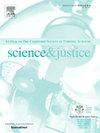象牙还是骨头?利用ATR-FTIR光谱和化学计量学进行鉴别
IF 1.9
4区 医学
Q2 MEDICINE, LEGAL
引用次数: 0
摘要
象牙是非法野生动物贸易中价格最高的物品/产品之一。需求的增加和大象数量的减少导致许多天然和人工象牙替代品大量涌入非法野生动物市场。鉴别真象牙并将其与替代品区分开来是后续法律诉讼和相关法律成功实施的必要条件。本研究采用化学计量学的ATR-FTIR光谱技术对30个亚洲象象牙和29个牛骨样品进行了分析。象牙和骨样品的ATR-FTIR光谱在中红外范围内进行了视觉比较,并进行了高级化学计量分析。所建立的PCA模型区分了象牙和牛骨样本,准确率为98.30%。PLS-DA模型成功地将象牙和骨样品划分为离散类,其校准R平方值为0.99。PLSDA-V模型还利用具有VIP评分的x变量进行了开发;将象牙和骨骼样本区分为不同的类别。结果表明,PLS-DA模型在准确率高、错误率低方面优于PLSDA-V模型。随后,单独采用PLS-DA模型进行外部验证和盲测。此外,通过ATR-FTIR光谱的视觉比较,树脂基假象牙样品也与真象牙样品进行了区分。研究结果表明,ATR-FTIR光谱可以快速、精确、无损地识别和区分象牙和骨骼样品,即使它们是粉末状的,并且已经失去了它们的形态特征。本文章由计算机程序翻译,如有差异,请以英文原文为准。

Ivory or Bone? discrimination using ATR-FTIR spectroscopy and chemometrics
Elephant ivory is one of the most priced items/products in the illegal wildlife trade. Its increased demand and the dwindling population of elephants have led to a heavy influx of many natural and artificial elephant ivory substitutes in the illegal wildlife market. Identification of genuine elephant ivory and distinguishing it from substitutes is mandatory for subsequent legal proceedings and successful implementation of the related laws. In this study, 30 Asian elephant (Elephas maximus) ivory and 29 cattle (Bubalus bubalis) bone samples were evaluated using ATR-FTIR spectroscopy with chemometrics. ATR-FTIR spectra of ivory and bone samples in the mid-IR range were visually compared and subjected to advanced chemometric analysis. The developed PCA model differentiated the ivory and cattle bone samples, with 98.30 % accuracy. PLS-DA model successfully differentiated ivory and bone samples into discrete classes with a calibration R square value of 0.99. A PLSDA-V model was also developed utilizing X-variables with a VIP score > 1 that distinguished ivory and bone samples into discrete classes. It was observed that the PLS-DA model outperformed the PLSDA-V model in terms of high accuracy and low error rates. Subsequently, the PLS-DA model was employed solely for external validation and blind tests. Furthermore, resin-based fake ivory samples were also differentiated from genuine ivory samples through visual comparison of their ATR-FTIR spectra. The findings of the study showed that ATR-FTIR spectroscopy could identify and differentiate ivory and bone samples, even when they are in powdered form and have lost their morphological characteristics in a quick, precise, non-destructive manner.
求助全文
通过发布文献求助,成功后即可免费获取论文全文。
去求助
来源期刊

Science & Justice
医学-病理学
CiteScore
4.20
自引率
15.80%
发文量
98
审稿时长
81 days
期刊介绍:
Science & Justice provides a forum to promote communication and publication of original articles, reviews and correspondence on subjects that spark debates within the Forensic Science Community and the criminal justice sector. The journal provides a medium whereby all aspects of applying science to legal proceedings can be debated and progressed. Science & Justice is published six times a year, and will be of interest primarily to practising forensic scientists and their colleagues in related fields. It is chiefly concerned with the publication of formal scientific papers, in keeping with its international learned status, but will not accept any article describing experimentation on animals which does not meet strict ethical standards.
Promote communication and informed debate within the Forensic Science Community and the criminal justice sector.
To promote the publication of learned and original research findings from all areas of the forensic sciences and by so doing to advance the profession.
To promote the publication of case based material by way of case reviews.
To promote the publication of conference proceedings which are of interest to the forensic science community.
To provide a medium whereby all aspects of applying science to legal proceedings can be debated and progressed.
To appeal to all those with an interest in the forensic sciences.
 求助内容:
求助内容: 应助结果提醒方式:
应助结果提醒方式:


